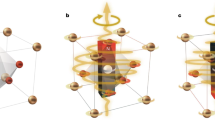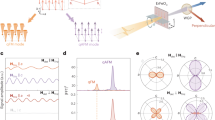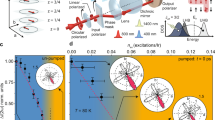Abstract
Controlling the functional properties of quantum materials with light has emerged as a frontier of condensed-matter physics, leading to the discovery of various light-induced phases of matter, such as superconductivity1, ferroelectricity2,3, magnetism4,5,6 and charge density waves7. However, in most cases, the photoinduced phases return to equilibrium on ultrafast timescales after the light is turned off, limiting their practical applications. Here we use intense terahertz pulses to induce a metastable magnetization with a remarkably long lifetime of more than 2.5 milliseconds in the van der Waals antiferromagnet FePS3. The metastable state becomes increasingly robust as the temperature approaches the antiferromagnetic transition point, suggesting that critical order parameter fluctuations play an important part in facilitating the extended lifetime. By combining first-principles calculations with classical Monte Carlo and spin dynamics simulations, we find that the displacement of a specific phonon mode modulates the exchange couplings in a manner that favours a ground state with finite magnetization near the Néel temperature. This analysis also clarifies how the critical fluctuations of the dominant antiferromagnetic order can amplify both the magnitude and the lifetime of the new magnetic state. Our discovery demonstrates the efficient manipulation of the magnetic ground state in layered magnets through non-thermal pathways using terahertz light and establishes regions near critical points with enhanced order parameter fluctuations as promising areas to search for metastable hidden quantum states.
This is a preview of subscription content, access via your institution
Access options
Access Nature and 54 other Nature Portfolio journals
Get Nature+, our best-value online-access subscription
$32.99 / 30 days
cancel any time
Subscribe to this journal
Receive 51 print issues and online access
$199.00 per year
only $3.90 per issue
Buy this article
- Purchase on SpringerLink
- Instant access to full article PDF
Prices may be subject to local taxes which are calculated during checkout




Similar content being viewed by others
Data availability
Datasets collected and/or analysed during the current study are available from the corresponding author upon request. Source data are provided with this paper.
Code availability
The codes used to generate the data for this study are available from the corresponding author upon request.
References
Mitrano, M. et al. Possible light-induced superconductivity in K3C60 at high temperature. Nature 530, 461–464 (2016).
Nova, T. F., Disa, A. S., Fechner, M. & Cavalleri, A. Metastable ferroelectricity in optically strained SrTiO3. Science 364, 1075–1079 (2019).
Li, X. et al. Terahertz field–induced ferroelectricity in quantum paraelectric SrTiO3. Science 364, 1079–1082 (2019).
McLeod, A. S. et al. Multi-messenger nanoprobes of hidden magnetism in a strained manganite. Nat. Mater. 19, 397–404 (2020).
Disa, A. S. et al. Polarizing an antiferromagnet by optical engineering of the crystal field. Nat. Phys. 16, 937–941 (2020).
Disa, A. S. et al. Photo-induced high-temperature ferromagnetism in YTiO3. Nature 617, 73–78 (2023).
Kogar, A. et al. Light-induced charge density wave in LaTe3. Nat. Phys. 16, 159–163 (2020).
Sedrakyan, T. A. & Chubukov, A. V. Pseudogap in underdoped cuprates and spin-density-wave fluctuations. Phys. Rev. B 81, 174536 (2010).
Ye, M. & Chubukov, A. V. Hubbard model on a triangular lattice: pseudogap due to spin density wave fluctuations. Phys. Rev. B 100, 35135 (2019).
Miiller, K. A., Berlinger, W. & Tosatti, E. Indication for a novel phase in the quantum paraelectric regime of SrTiO3. Z. Phys. B Condens. Matter 84, 277583 (1991).
Latini, S. et al. The ferroelectric photo ground state of SrTiO3: cavity materials engineering. Proc. Natl Acad. Sci. USA 118, e2105618118 (2021).
Viñas Boström, E., Sriram, A., Claassen, M. & Rubio, A. Controlling the magnetic state of the proximate quantum spin liquid α-RuCl3 with an optical cavity. npj Comput. Mater. 9, 202 (2023).
Afanasiev, D. et al. Ultrafast control of magnetic interactions via light-driven phonons. Nat. Mater. 20, 607–611 (2021).
Stojchevska, L. et al. Ultrafast switching to a stable hidden quantum state in an electronic crystal. Science 344, 177–180 (2014).
de la Torre, A. et al. Colloquium: nonthermal pathways to ultrafast control in quantum materials. Rev. Mod. Phys. 93, 41002 (2021).
Brec, R., Schleich, D. M., Ouvrard, G., Louisy, A. & Rouxel, J. Physical properties of lithium intercalation compounds of the layered transition-metal chalcogenophosphites. Inorg. Chem. 18, 1814–1818 (1979).
Lee, J.-U. et al. Ising-type magnetic ordering in atomically thin FePS3. Nano Lett. 16, 7433–7438 (2016).
Kim, K. et al. Suppression of magnetic ordering in XXZ-type antiferromagnetic monolayer NiPS3. Nat. Commun. 10, 345 (2019).
Kim, K. et al. Antiferromagnetic ordering in van der Waals 2D magnetic material MnPS3 probed by Raman spectroscopy. 2D Mater. 6, 041001 (2019).
Joy, P. A. & Vasudevan, S. Magnetism in the layered transition-metal thiophosphates MPS3 (M=Mn, Fe, and Ni). Phys. Rev. B 46, 5425–5433 (1992).
Sivadas, N., Daniels, M. W., Swendsen, R. H., Okamoto, S. & Xiao, D. Magnetic ground state of semiconducting transition-metal trichalcogenide monolayers. Phys. Rev. B 91, 235425 (2015).
Ergeçen, E. et al. Coherent detection of hidden spin-lattice coupling in a van der Waals antiferromagnet. Proc. Natl Acad. Sci. USA 120, e2208968120 (2023).
Zhou, F. et al. Dynamical criticality of spin-shear coupling in van der Waals antiferromagnets. Nat. Commun. 13, 6598 (2022).
Kang, S. et al. Coherent many-body exciton in van der Waals antiferromagnet NiPS3. Nature 583, 785–789 (2020).
Ergeçen, E. et al. Magnetically brightened dark electron-phonon bound states in a van der Waals antiferromagnet. Nat. Commun. 13, 98 (2022).
Belvin, C. A. et al. Exciton-driven antiferromagnetic metal in a correlated van der Waals insulator. Nat. Commun. 12, 4837 (2021).
Wildes, A. R., Zhitomirsky, M. E., Ziman, T., Lançon, D. & Walker, H. C. Evidence for biquadratic exchange in the quasi-two-dimensional antiferromagnet FePS3. J. Appl. Phys. 127, 223903 (2020).
Zong, A. et al. Spin-mediated shear oscillators in a van der waals antiferromagnet. Nature 620, 988–993 (2023).
McCreary, A. et al. Quasi-two-dimensional magnon identification in antiferromagnetic FePS3 via magneto-Raman spectroscopy. Phys. Rev. B 101, 64416 (2020).
Liu, S. et al. Direct observation of magnon-phonon strong coupling in two-dimensional antiferromagnet at high magnetic fields. Phys. Rev. Lett. 127, 97401 (2021).
Zhang, Q. et al. Coherent strong-coupling of terahertz magnons and phonons in a Van der Waals antiferromagnetic insulator. Preprint at https://arxiv.org/abs/2108.11619 (2021).
Mertens, F. et al. Ultrafast coherent THz lattice dynamics coupled to spins in the van der Waals antiferromagnet FePS3. Adv. Mater. 35, 2208355 (2023).
Zhang, X.-X. et al. Spin dynamics slowdown near the antiferromagnetic critical point in atomically thin FePS3. Nano Lett. 21, 5045–5052 (2021).
Lançon, D. et al. Magnetic structure and magnon dynamics of the quasi-two-dimensional antiferromagnet FePS3. Phys. Rev. B 94, 214407 (2016).
Ferrenberg, A. M., Xu, J. & Landau, D. P. Pushing the limits of Monte Carlo simulations for the three-dimensional Ising model. Phys. Rev. E 97, 43301 (2018).
Hohenberg, P. C. & Halperin, B. I. Theory of dynamic critical phenomena. Rev. Mod. Phys. 49, 435–479 (1977).
Zhang, Z. et al. Discovery of enhanced lattice dynamics in a single-layered hybrid perovskite. Sci. Adv. 9, eadg4417 (2023).
Juraschek, D. M. & Maehrlein, S. F. Sum-frequency ionic Raman scattering. Phys. Rev. B 97, 174302 (2018).
Cui, J. et al. Chirality selective magnon-phonon hybridization and magnon-induced chiral phonons in a layered zigzag antiferromagnet. Nat. Commun. 14, 3396 (2023).
Khalsa, G., Benedek, N. A. & Moses, J. Ultrafast control of material optical properties via the infrared resonant raman effect. Phys. Rev. X 11, 021067 (2021).
Padmanabhan, P. et al. Coherent helicity-dependent spin-phonon oscillations in the ferromagnetic van der Waals crystal CrI3. Nat. Commun. 13, 4473 (2022).
Padmanabhan, H. et al. Interlayer magnetophononic coupling in MnBi2Te4. Nat. Commun. 13, 1929 (2022).
Gonze, X. et al. The Abinit project: impact, environment and recent developments. Comput. Phys. Commun. 248, 107042 (2020).
Gonze, X. First-principles responses of solids to atomic displacements and homogeneous electric fields: implementation of a conjugate-gradient algorithm. Phys. Rev. B 55, 10337–10354 (1997).
Amadon, B. et al. Plane-wave based electronic structure calculations for correlated materials using dynamical mean-field theory and projected local orbitals. Phys. Rev. B 77, 205112 (2008).
Torrent, M., Jollet, F., Bottin, F., Zérah, G. & Gonze, X. Implementation of the projector augmented-wave method in the ABINIT code: application to the study of iron under pressure. Comput. Mater. Sci. 42, 337–351 (2008).
Pizzi, G. et al. Wannier90 as a community code: new features and applications. J. Phys. Condens. Matter 32, 165902 (2020).
He, X., Helbig, N., Verstraete, M. J. & Bousquet, E. TB2J: a Python package for computing magnetic interaction parameters. Comput. Phys. Commun. 264, 107938 (2021).
Vaclavkova, D. et al. Magnon polarons in the van der Waals antiferromagnet FePS3. Phys. Rev. B 104, 134437 (2021).
Lee, Y. et al. Giant magnetic anisotropy in the atomically thin van der Waals antiferromagnet FePS3. Adv. Electron. Mater. 9, 2200650 (2023).
Momma, K. & Izumi, F. VESTA 3 for three-dimensional visualization of crystal, volumetric and morphology data. J. Appl. Crystallogr. 44, 1272–1276 (2011).
Acknowledgements
We thank A. Zong, B. Fichera, D. Juraschek, H. Ning, M. Eckstein and Z. Alpichshev for their discussions. We acknowledge the support from the US Department of Energy, Materials Science and Engineering Division, Office of Basic Energy Sciences (BES DMSE) (data taking and analysis) and the EPiQS Initiative grant GBMF9459 (instrumentation and manuscript writing) of the Gordon and Betty Moore Foundation. E.V.B. acknowledges funding from the Horizon Europe research and innovation programme of the European Union under the Marie Skłodowska–Curie grant agreement no. 101106809. A.R. was supported by the Cluster of Excellence Advanced Imaging of Matter (AIM), Grupos Consolidados (IT1249-19), SFB925, ‘Light Induced Dynamics and Control of Correlated Quantum Systems’ and the Max Planck Institute New York City Center for Non-Equilibrium Quantum Phenomena. Z.Z. and K.A.N. acknowledge support from the US Department of Energy, Office of Basic Energy Sciences, under award no. DESC0019126. The work at SNU was supported by the Leading Researcher Program of the National Research Foundation of Korea (grant no. 2020R1A3B2079375).
Author information
Authors and Affiliations
Contributions
B.I., T.L. and N.G. conceived the study. B.I. and T.L. designed and built the experimental setup and performed the measurements. E.V.B. and A.R. performed the first-principles calculations and Monte Carlo simulations. Z.Z. performed experiments with THz generated from LiNbO3 under the supervision of K.A.N. J.P. and J.K. synthesized and characterized FePS3 single crystals under the supervision of J.-G.P.; B.I., T.L. and A.v.H performed the data analysis. B.I., T.L., A.v.H and N.G. interpreted the data and wrote the paper with inputs from E.V.B. and A.R. and all other authors. The project was supervised by N.G.
Corresponding author
Ethics declarations
Competing interests
The authors declare no competing interests.
Peer review
Peer review information
Nature thanks the anonymous reviewers for their contribution to the peer review of this work.
Additional information
Publisher’s note Springer Nature remains neutral with regard to jurisdictional claims in published maps and institutional affiliations.
Extended data figures and tables
Extended Data Fig. 1 Crystal structure of FePS3.
a. Crystal structure schematics of the a-c plane projected along b*-axis. b. a-b plane projected along c*-axis. c. 3D view of the crystal structure. All the structures were generated by VESTA software51.
Extended Data Fig. 2 Experimental setup.
a. Detailed schematics of the experimental setup. The abbreviations used here: BS - beam splitter; OPA - optical parametric amplifier; PM - parabolic mirror; L - lens; HWP - half wave plate; QWP - quarter wave plate; PD - photo-diode. b. Field profile of the THz pulse. Peak field strength is ~300 kV/cm. Fourier spectrum of the field is shown in the inset.
Extended Data Fig. 3 Field strength dependencies of other low energy modes.
a, b, c, and d are THz field strength dependencies of the 2.64 THz phonon, 3.69 THz magnon, 4.80 THz phonon, and 7.51 THz phonon mode amplitudes, respectively. Dashed lines in a and b are linear fits, whereas in c and d the fits are quadratic. The lower panels are the modulation patterns of the nearest-neighbour exchange interactions under the corresponding phonon displacements. The Q1 (2.64 THz) and Q4 (7.51 THz) phonons induce so called columnar modulations (see Supplementary Note 5). Since the columnar phase is far from the zig-zag phase, the contributions of these two phonons to the Ginzburg-Landau free energy can be neglected. The Q3 (4.80 THz) phonon has a “zig-zag” type modulations, and it couples individually to M2 and L2. Unless there is a mechanism that breaks the degeneracy between opposite signs of magnetization, the Q3 is also not expected to generate a net magnetization. These findings are further supported by spin Monte Carlo simulations (see Supplementary Note 6), and therefore, we neglect their contributions in the main text.
Extended Data Fig. 4 THz field-induced circular and linear dichroism and temperature dependence.
a. THz-induced circular dichroism ΔCD measurements at 118K (green) and at 140K (grey). ΔCD is measured as a difference in transmittance of right-circularly polarized (RCP) and left-circularly polarized (LCP) probe beams. At high temperature (140K) ΔCD signal is absent, indicating there are no experimental artifacts in our setup that would result in ΔCD signal. b. Suppression of equilibrium linear dichroism by THz pulse at 118K. In equilibrium, transmission of horizontally polarized light is 2.3 times larger than the vertically polarized light, which reduces by ~1% after THz pumping, as shown in b. Since LD is proportional to the square of zigzag AFM order parameter, we can conclude that the THz pulse suppresses the AFM order by about ~0.5%. c. Raw data of temperature dependent Δη experiments performed near Néel temperature with fine steps. It shows a marked change near transition point. A box with black dashed lines marks the region near transition a build-up of pre-time zero signal. Figure 2e in the Main Text is obtained by measuring the signal amplitude at long time delays (~170 ps). The pre-timezero signal decreases with temperature for T < 118K, whereas it increases with increasing temperature for higher temperatures.
Extended Data Fig. 5 Importance of nonlinearly excited low energy modes and THz field strength dependence of the metastable signal.
We repeat the same experiment with single-cycle THz excitation pulses generated from LiNbO3 by tilted-pulse-front technique. The THz spectrum is given in a (blue), that is below the lowest phonon observed in FePS3. In b we compare signals induced by two different THz pulses generated by organic crystal (BNA) and LiNbO3 (see Methods) at T = 118 K, and in the case of LiNbO3 we did not observe any long-lived signal. c. The amplitude of the metastable signal is quadratic in THz field amplitude. This is in agreement with the expected linear dependence of the induced M on the phonon displacement Q2, whereas Q2 has an excitation pathway quadratic on ETHz. Hence M is expected to scale quadratically with ETHz.
Extended Data Fig. 6 Mode spectra measured at 90K and 10K with a wider temporal window.
Spectra of collective excitations as measured in the polarization rotation (a) and ellipticity change (b) channels at 90K. The detection scheme in these two channels use half waveplate (HWP) and quarter waveplate (QWP), respectively. The relative amplitudes of the modes in the energy window between 2 THz to 5 THz, are more pronounced in the polarization rotation channel. c. A time trace of THz-induced ellipticity change signal with a longer temporal window. d. Fourier transform of the oscillations in a. Owing to the longer time window, the frequency resolution is enhanced, which enabled to resolve the splitting of the two magnon energies by ~ 0.033 THz = 0.13 meV. Additionally, in this set of measurements, we can observe the mode at 2.83 THz.
Supplementary information
Supplementary Information
This file contains Supplementary Notes, Supplementary Figs. 1–15 and Supplementary References.
Supplementary Table 1
Equilibrium magnetic interactions parameters of FePS3. The magnetic exchange interactions for the nearest neighbour (subscript 1), next nearest neighbour (subscript 2) and third nearest neighbour interactions (subscript 3) were used to obtain the equilibrium properties of FePS3 by simulated annealing. The superscript denotes the interactions on intra-chain (ferromagnetic, F) and inter-chain (antiferromagnetic, A) bonds. The single-ion anisotropy is denoted by Δ.
Rights and permissions
Springer Nature or its licensor (e.g. a society or other partner) holds exclusive rights to this article under a publishing agreement with the author(s) or other rightsholder(s); author self-archiving of the accepted manuscript version of this article is solely governed by the terms of such publishing agreement and applicable law.
About this article
Cite this article
Ilyas, B., Luo, T., von Hoegen, A. et al. Terahertz field-induced metastable magnetization near criticality in FePS3. Nature 636, 609–614 (2024). https://doi.org/10.1038/s41586-024-08226-x
Received:
Accepted:
Published:
Issue date:
DOI: https://doi.org/10.1038/s41586-024-08226-x
This article is cited by
-
Time-domain study of coupled collective excitations in quantum materials
npj Quantum Materials (2025)
-
Terahertz control of linear and nonlinear Magno-phononics
Nature Communications (2025)
-
Simple THz Phase Retarder Based on Mach–Zehnder Interferometer for Polarization Control
Journal of Infrared, Millimeter, and Terahertz Waves (2025)



